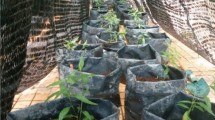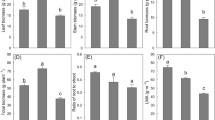Abstract
Concentrations of toxic norditerpenoid alkaloids vary greatly in tall larkspur (Delphinium barbeyi) and may be influenced by environmental stress. We evaluated the effect of shade, darkness, and inhibition of photosynthesis on toxic alkaloid concentration. In plants treated with metribuzin to inhibit photosynthesis, alkaloid concentration increased, but dry weight of the plants decreased as growth ceased, leaving absolute alkaloid content similar to that of control plants. Short-term shade (70% reduction in sunlight for three days), dark treatments from leaves collected at night, and aluminum foil covered leaves all increased alkaloid concentration in comparison to untreated control plants. It appears that absolute amounts of alkaloids remained the same, but the mass of stressed plants declined as nonstructural carbohydrates were depleted, thus increasing the relative concentration of alkaloids. We conclude that norditerpenoid alkaloids in larkspur do not respond to short-term light stress. Alkaloid concentration was lower in larkspur plants growing beneath forest canopy and in potted plants in a long-term shade study (70% reduction in sun light for 21 days) than plants growing in open sunlight. Long-term shade may have reduced synthesis of norditerpenoid alkaloids, particularly in the earlier developmental stages of the plant. Shade stress or photosynthesis inhibition apparently did not increase norditerpenoid alkaloid synthesis, which contrasts with the carbon/nutrient balance theory of plant defense.
Similar content being viewed by others
REFERENCES
Aerts, R. J., Snoeijer, W., Aerts-Teorlink, O., vander Meijden, E., and Verpoorte, R. 1991. Control and biological implications of alkaloid synthesis in Cinchona seedlings. Phytochemistry 30:3571–3577.
Baldwin, I. T. 1988. Damaged-induced alkaloids in tobacco: Pot-bound plants are not indictable. J. Chem. Ecol. 14:1113–1120.
Baldwin, I. T. 1991. Damage induced alkaloids in wild tobacco, pp. 47–69, in D. W. Tallamy and M. J. Raupp (eds.). Phytochemical Induction by Herbivores. John Wiley & Sons, New York.
Bryant, J. P., Chapin, F. S., and Klein, D. R. 1983. Carbon/nutrient balance in boreal plants in relation to vertebrate herbivory. Oikos 40:357–368.
Bryant, J. P., Reichardt, P. B., and Clausen, T. P. 1992. Chemically mediated interactions between woody plants and browsing mammals. J. Range. Manage. 45:18–24.
Coleman, J. S., Jones, C. G., and Smith, W. A. 1987. The effect of ozone on cottonwood leaf rust interactions: independence of abiotic stress, genotype and leaf ontogeny. Can. J. Bot. 65:949–953.
Coley, P. D., Bryant, J. P., and Chapin, F. S. III. 1985. Resource availability and plant anti-herbivore defense. Science 230:895–899.
DeLuca, V., Fernandez, J. A., Campbell, D., and Kurz, W. G. W. 1988. Developmental regulation of enzymes of indole alkaloid biosynthesis in Catharanthus roseus. Plant Physiol. 86:447–450.
Devine, M. D., Duke, S. O., and Fedtke, C. 1993. Physiology of Herbicide Actions. Prentice-Hall, Englewood Cliffs, New Jersey, pp. 113–140.
Frischknecht, P. M., Almer-Dufek, J., Bauman, T. W. 1986. Purine alkaloid formation in buds and developing leaflets of Coffea arabica: Expression of an optimal defense strategy? Phytochem. 25:613–616.
Fujimori, N., Suzuki, T., and Ashihora, H. 1991. Seasonal variation in biosynthetic capacity for synthesis of caffeine in tea leaves. Phytochemistry 30:2245–2248.
Gardner, D. R., Manners, G. D., Ralphs, M. H., and Pfister, J. A. 1997. Quantitative analysis of norditerpenoid alkaloids in larkspur (Delphinium spp.). Phytochem. Anal. 8:55–62.
Gershenzon, J. 1994. Metabolic costs of terpenoid accumulation in higher plants. J. Chem. Ecol. 20:1281–1328.
Halkier, B. A., and Moller, B. L. 1989. Biosynthesis of the cyanogenic glucoside dhurrin in seedlings of Sorghum bicolor (L.) and partial purification of the enzyme system involved. Plant Physiol. 90:1552–1559.
Lerdau, M., Litvak, M., and Monson, R. 1994. Plant chemical defense: Monoterpenes and the growth-differentiation balance hypothesis. Trends Ecol. Evol. 9:58–61.
Lorio, P. L., Jr. 1986. Growth differentiation balance: A basis for understanding southern pine beetle-tree interactions. Forest Ecol. Manage. 14:259–278.
Majak, W., Parkinson, P. D., Williams, R. J., Looney, N. E., and VanRyswyk, A. L. 1977. The effect of light and moisture on Columbia milkvetch toxicity in lodgepole pine forests. J. Range Manage. 30:423–427.
Manners, G. D., and Pfister, J. A. 1993. Normal phase liquid chromatographic analysis of toxic norditerpenoid alkaloids. Phytochem. Anal. 4:14–18.
Manners, G. D., and Pfister, J. A. 1996. Sampling a poisonous plant population: Quantifying toxic alkaloids in tall larkspur (Delphinium barbeyi) leaves. Weed Sci. 44:782–788.
Manners, G. D., Panter, K. E., Ralphs, M. H., Pfister, J. A., Olsen, J. D., and James, L. F. 1993. Toxicity and chemical phenology of norditerpenoid alkaloids in the tall larkspurs (Delphinium species). J. Agric. Food Chem. 41:96–100.
Manners, G. D., Panter, K. E., and Pelletier, S. W. 1995. Structure-activity relationships of norditerpenoids alkaloids occurring in toxic larkspur (Delphinium) species. J. Nat. Prod. 58:863–869.
Mooney, H. A., Gulmon, S. L., and Johnson, N. D. 1983. Physiological constraints on plant chemical defenses, pp. 21–36, in P. A. Hedin (ed.). Plant Resistance to Insects. ACS Symposium Series No. 208, American Chemical Society, Washington, DC.
Nielsen, D. B. and Ralphs, M. H. 1988. Larkspur: Economic considerations, pp. 119–130, in L. F. James, M. H. Ralphs, and D. B. Nielsen (eds.). The Ecology and Economic Impact of Poisonous Plants on Livestock Production. Westview Press, Boulder, Colorado.
Olsen, J. D. 1978. Tall larkspur poisoning in cattle and sheep. J. Am. Vet. Med. Assoc. 173:762–765.
Pfister, J. A., Ralphs, M. H., and Manners, G. D. 1988. Cattle grazing tall larkspur on Utah mountain rangeland. J. Range Manage. 41:118–122.
Pfister, J. A., Manners, G. D., Gardner, D. R., and Ralphs, M. H. 1994. Toxic alkaloid levels in tall larkspur (Delphinium barbeyi) in western Colorado. J. Range Manage. 47:355–358.
Porter, A. J. R., Morton, A. M., Kiddle, G., Doughty, K. J., and Wallsgroce, R. M. 1991. Variation in the glucosinolate content of oilseed rape leaves: (1) Effect on leaf age and position. Ann. Appl. Biol. 118:461–467.
Ralphs, M. H., Olsen, J. D., Pfister, J. A., and Manners, G. D. 1988. Plant-animal interactions in larkspur poisoning in cattle. J. Anim. Sci. 66:2334–2342.
Ralphs, M. H., Manners, G. D., Pfister, J. A., Gardner, D. R., and James, L. F. 1997. Toxic alkaloid concentration in tall larkspur species in the western US. J. Range Manage. 50:497–502.
Ralphs, M. H., Gardner, D. A., Jones, W. A., and Manners, G. D. 1998. Norditerpenoid alkaloid concentration in tall larkspur plants damaged by the larkspur mirid. J. Chem. Ecol. Submitted.
Smart, D. R., Chatterton, N. J., and Bugbee, B. 1994. The influence of elevated CO2 on nonstructural carbohydrate distribution and fructan accumulation in wheat canopies. Plant Cell Environ. 17:435–442.
Van Dam, N. M. and Vrieling, K. 1994. Genetic variation in constitutive and inducible pyrrolizidine alkaloid levels in Cynglossum officinale L. Oecologia 99:374–378.
Vrieling, K., De Vos, H., and Van Wijk, C. A. M. 1993. Genetic analysis of the concentrations of pyrrolizidine alkaloids in Senecio jacobaea. Phytochemistry 32:1141–1144.
Wink, M., and Witte, L. 1984. Turnover and transport of quinolizidine alkaloids. Diurnal fluctuations of lupanine in the phloem sap, leaves and fruits of Lupinus albus. Planta 161:519–524.
Zangerl, A. R., and Brenenbaum, M. R. 1990. Furanocoumarin induction in wild parsnip: Genetics and population variation. Ecology 71:1933–1940.
Author information
Authors and Affiliations
Rights and permissions
About this article
Cite this article
Ralphs, M.H., Manners, G.D. & Gardner, D.R. Influence of Light and Photosynthesis on Alkaloid Concentration in Larkspur. J Chem Ecol 24, 167–182 (1998). https://doi.org/10.1023/A:1022301331804
Issue Date:
DOI: https://doi.org/10.1023/A:1022301331804




